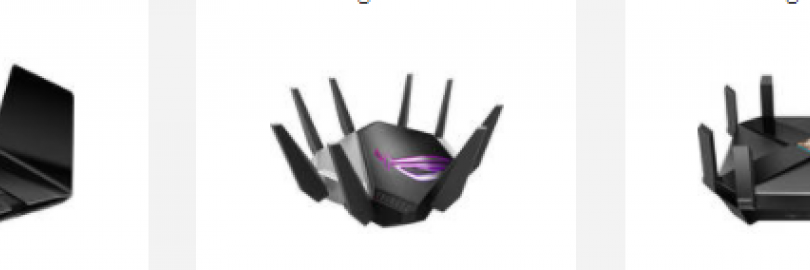
TP-Link Archer AX6000 vs. ASUS AX11000 vs. Netgear Nighthawk RAX120: Which Makes the Best Wi-Fi 6 Router?
Money Saving Tips First:
You can save up to 100% on online shopping at home and abroad!
Such a high amount of cash back comes from Extrabux (What is Extrabux?), it also offers coupon codes and recent promotions, and brings together 10,000+ sites (US, China, UK, Japan, Australia , Germany, France, Italy, etc.).
Just sign up for an Extrabux account and earn exciting cash back every time you place an order via the relevant link. Sign-Up Bonus: Join for FREE & Earn $20 Welcome Bonus today! Then earn $5 Friend Referral Bonus!
Whether you are buying cheap domestic products, international luxury goods, or buying mobile phones, computers, refrigerators, washing machines, clothes, shoes, bags, mother and baby products, snacks, drinks, or booking air tickets, hotels, car rentals, or buying services and memberships , you can save money on all related purchases - save $1,000 a year!
What are the best Wi-Fi 6 router brands?
Since most new devices support the protocol, Wi-Fi 6 has become the current standard for WI-Fi devices and routers. Wi-Fi 6 has made its way to a cheaper router that most people are interested in buying without giving up the best features that come with it. The most popular Wi-Fi 6 router brands in the world are TP-Link, ASUS, Netgear. The most popular models of them are:
Best overall: TP-Link Archer AX6000 ($279.99, Get Up To 1.5% Cash Back with B&H Photo Video)

Best for gaming: Asus Rapture GT-AXE1000($549.99, Get Up To 1.5% Cash Back with B&H Photo Video)

Best for stream: Netgear Nighthawk RAX120($449.99, Get Up To 1.5% Cash Back with B&H Photo Video)

TP-Link, ASUS, Netgear Comparison: Which Router Model Is Best for Me?
Design Comparison: TP-Link Archer AX6000 vs Asus Rapture GT-AXE1000 vs Netgear Nighthawk RAX120
The AX6000 takes a more subtle approach to design than its flamboyant gaming counterparts (like the flagship Archer AX11000). While it comes with eight permanently attached antennae and a horizontal design, it goes with a black plastic exterior that looks more business than gaming. But there's some flash here, in the form of an LED on the top center, behind a shiny gold TP-Link badge, that glows blue when all is working (and red when it isn't). But the light is easily disabled with a dedicated hardware button--important if your router lives near your TV or in a bedroom.
Similar to AX6000, The Asus ROG Rapture GT-AX11000 is a horizontal router with no less than eight antennas deployed circumferentially around its chunky, square body, two to each side. To complete the look, the ROG logo in the center of the router is lit by Aura RGB, which thankfully can be turned off for those times when, for some reason, you don't want to draw attention to the large techno-crab-looking beast at the heart of your wireless world.
AX6000 is on the larger end of the spectrum at 10.3 × 10.3 × 2.4 inches, and it weighs 3.5 pounds. That's nearly as big as the Asus Rapture GT-AXE1000, at 10.4 x 10.4 x 2.9 inches and 3.94 pounds. But the Archer AX6000's antennae are shorter than on most routers, and they come permanently attached, so all you have to do when taking the router out of the box is flip them up.
If you want a good-looking, high-performance Wi-Fi 6 router, Netgear's Nighthawk RAX120 won't disappoint. A pair of wings swept like an eagle gives it a sleek, futuristic design. These wings are more than just cool looks, though, as they also allow it to hide eight high-performance beamforming antennas without them jutting out in every direction like some kind of high-tech spider. It's a very clean design that allows you to display the RAX120 comfortably on a bookcase rather than hiding it in your basement.
Winner:Netgear's Nighthawk RAX120
Hardware Comparison: TP-Link Archer AX6000 vs Asus Rapture GT-AXE1000 vs Netgear Nighthawk RAX120
All three routers offer premium hardware.
The RAX120 features a 2.2GHz quad-core processor, 512MB of RAM and 1GB of flash memory. High-quality hardware helps ensure consistent and reliable performance.
The ROG Rapture GT-AX11000 has a quad-core 1.8 GHz CPU with access to 256MB of NAND and 1GB of DDR3 SDRAM. The 1.8GHz quad-core processor provides enough power to handle dozens of devices you may have in your home.
Like the Nighthawk RAX120, the Archer AX6000 has a quad-core processor, but the Nighthawk’s processor is 2.2 GHz, while the TP-Link Archer’s CPU is only 1.8 GHz.
The AX6000 can go head to head with higher-end routers. Because it has a 1.8 GHz quad-core processor with two additional co-processors, 1 GB of RAM and 128 MB of flash memory.
Winner:Netgear's Nighthawk RAX120
Port Comparison: TP-Link Archer AX6000 vs Asus Rapture GT-AXE1000 vs Netgear Nighthawk RAX120
| Ports | ASUS ROG GT-AX11000 | TP-Link Archer AX6000 | Netgear Nighthawk AX12 |
| 1 x 2.5 Gb/s Ethernet (RJ45) 1 x 10/100/1000 Mb/s Gigabit Ethernet (RJ45) (Uplink) 4 x 10/100/1000 Mb/s Gigabit Ethernet (RJ45) (Console) 2 x 5 Gb/s USB Type-A | 1 x 2.5 Gb/s Ethernet (RJ45) (Uplink) 8 x 10/100/1000 Mb/s Gigabit Ethernet (RJ45) (Console) 1 x 5 Gb/s USB Type-A 1 x 5 Gb/s USB Type-C | 1 x 5 Gb/s Ethernet (RJ45) 1 x 10/100/1000 Mb/s Gigabit Ethernet (RJ45) (Uplink) 4 x 10/100/1000 Mb/s Gigabit Ethernet (RJ45) (Console) 2 x 5 Gb/s USB Type-A |
The Archer AX6000 has something that most other routers don't - an abundance of ports and wired connections. A 2.5Gbps WAN port works with even the fastest internet connections, while a total of 8 Ethernet ports give you connectivity for a plethora of wired devices. On the side of the router, you'll also find USB 3.0 Type-A and Type-C connectors, allowing you to quickly connect other peripherals such as NAS and home media servers.
The Nighthawk RAX120 also has two USB 3.0 storage ports on the back for direct connection to network storage, but you can't use them for printer sharing.
The RAX120 can also handle faster 2Gbps internet plans thanks to its ability to combine two of its six Gigabit Ethernet ports into an aggregated link. One of them is also a special 2.5/5Gbps Ethernet port that can be used to connect downstream hubs, high-performance game consoles or network attached storage (NAS) devices for maximum wired throughput.
The Rapture doesn't include a modem, so there's a dedicated Gigabit Ethernet port for connecting it to an existing broadband router or modem, and four other Gigabit Ethernet ports for wired connections to devices like game consoles or smart TVs connect.
And, for the true hardcore gamer, there's a "Multi-Gig" Ethernet port that supports speeds up to 2.5 Gb for super-fast internet access, or setting up your own gaming LAN at home. The Rapture also includes two USB 3.0 ports, allowing you to share printers or USB storage devices on your home network.
Overall, I was impressed with the location and specs of the ports, but I would have liked to see more Ethernet ports on such an expensive router.
Winner:TP-Link Archer AX6000
Performance Comparison: TP-Link Archer AX6000 vs Asus Rapture GT-AXE1000 vs Netgear Nighthawk RAX120
| Ports | ASUS ROG GT-AX11000 | TP-Link Archer AX6000 | Netgear Nighthawk AX12 |
| 2.4 GHz near | 398 | 400 Mbps | 325Mbps |
| 2.4 GHz far | 143 | 152 Mbps | 109Mbps |
| 5 GHz near | 1313 | 1315 Mbps | 1006 Mbps |
| 5 GHz far | 779 | 800 Mbps | 604 Mbps |
Take the Netgear Nighthawk AX12 as an example. The RAX120 is the AX6000 dual-band router (a tri-band version of the RAX200 with a second 5GHz band costs about $100).
"AX" in "AX6000" indicates that it supports Wi-Fi 6 (802.11ax), and "6000" indicates the combined maximum theoretical speed of each frequency band. Netgear rates speeds of 1,200 Mbps on the 2.4GHz band and 4,800 Mbps on the 5GHz band - but keep in mind these numbers are based on optimized, lab-based testing and don't take into account range, interference, and physical barriers And other factors. Your actual speed will be much lower.
In testing, the TP-Link Archer AX6000 offered the fastest download speeds.
The TP-Link Archer AX6000's 5GHz band was able to achieve an average speed well above 250 Mbps in most spaces, at 1,315 Mbps, but the speed dropped to 800 Mbps in the room furthest from the router.
The performance of the ASUS ROG GT-AX11000 is about the same as the TP-Link Archer AX6000. It clocked 1,313 Mbps at 5 feet, 779 Mbps at 75 feet, and maintained speeds of over 1,000 Mbps at mid-range at 37.5 feet.
Slightly behind in this round of competition is the RAX120, whose 5GHz band was able to hit average speeds of 1,000 Mbps in most spaces, but dropped to 604 Mbps in the room furthest from the router. That's still pretty fast! 604 Mbps is a great result, especially when you compare it to a slew of routers I've tested that have dropped into the single digits or dropped altogether.
To test file transfer performance, we tested write and read speeds by moving a 2GB folder containing photo, video, music, and office document files back and forth between a USB 3.0 drive connected to the router and a desktop PC. The RAX120 scored 79MBps in the write test, beating the Asus but not the TP-Link AX6000. The RAX120 scored 69MBps in the read test, but both the TP-Link AX6000 and Asus were a little faster.
Winner:TP-Link Archer AX6000
Setup Comparison: TP-Link Archer AX6000 vs Asus Rapture GT-AXE1000 vs Netgear Nighthawk RAX120
Setting up the Netgear Nighthawk RAX120 is easy. Fold the antenna wings up and lock into place without tools or screwing. After that, you just download the Nighthawk app and follow the instructions.
In the Nighthawk app, you can change your router's settings, create a guest network, control your router remotely, manage your devices individually, and test your network speed.
There's also a switch to turn off the LED lights, a terrific feature for light sleepers who keep the router in their bedroom.
Rapture is not for beginners. The router's quick start guide doesn't mention an iOS or Android app that can help you set up the router properly - it just tells you to use an Ethernet or Wi-Fi connection to connect to the router so you can configure the connection via the router's web browser interface The internet.
This might be fine for hardcore gamers who are used to configuring routers through a browser interface, but for others, it's not user-friendly at all. It also has complex 140-page manuals that really aren't designed for beginners. Asus' more traditional routers have a simple app to get you started.
Winner:Netgear's Nighthawk RAX120
Features Comparison: TP-Link Archer AX6000 vs Asus Rapture GT-AXE1000 vs Netgear Nighthawk RAX120
TP-Link's Archer AX6000 only has eight streams, but that doesn't stop it from being one of the most versatile Wi-Fi 6 routers you can get. The eight-stream AX6000 speed combined with TP-Link's HomeCare software makes the Archer an easy recommendation for homes looking for drop-in replacements for Ethernet switches and fast wireless access points.
TP-Link has some unique features to contribute.
The "band-steering" and "airtime-fairness" software helps make sure that bands don't get overcrowded, while also ensuring that one device doesn't get too much attention.
There's even Alexa compatibility if you want to give it voice commands.
The RAX120 is compatible with Alexa and Google Assistant, so you can use voice commands.
The GT-AX11000 packs a ton of features and is sure to satisfy nearly every reasonable use case for a gaming router. This includes an integrated V-P-N, the ability to create a mesh network with other ASUS routers, and a traffic analyzer.
The ASUS Rapture GT-AX1100 packs some serious networking features, boasting tri-band Wi-Fi 6 with speeds of up to 11000Mbps (11Gbps). The tri-band router is also set up with three separate networks, two on the 5GHz band and one on the 2.4GHz band, with the option to assign one of the bands as a dedicated gaming network that takes precedence over the other bands for best results performance.
Then there's Level 3 Boost, which prioritizes gaming ports; Game First V, client-side traffic shaping; Game Boost, ASUS' name for Game-First Adaptive Quality of Service; and WTFast, a private network for gamers. Yep, that's four, maybe it should be renamed to quad acceleration. Finally, there's Game Radar, which measures ping times to various servers in different locations around the world.
The router also supports ASUS AiMesh technology for mesh networking, so if you move to a larger home or office, you can choose to use it with other ASUS routers to create a wider network.
Winner:TP-Link Archer AX6000
Security Comparison: TP-Link Archer AX6000 vs Asus Rapture GT-AXE1000 vs Netgear Nighthawk RAX120
For security, the RAX120 features WPA3 support, the ability to connect via V-P-N, automatic firmware updates, and the ability to create a guest network. However, the RAX120 does not support Netgear Armor network security software. It would be great if there was an option to include some kind of software to protect the network from malware.
One aspect of Netgear's packaging that immediately feels dated is the Netgear Armor. Netgear Armor is actually a nice 30-day free trial, built right into the Nighthawk app. What works well is a vulnerability scanner, which tells you how to improve your network security. Armor will also tell you which devices Bitdefender Security can be installed on. This is in addition to automatic threat blocking from malicious sites.
Netgear Armor costs a whopping $69.99 per year, but you can get a discount for the first year. When you sign up for the service through the app, you will get the full price sign up auto-renewal fee, and you must also call Netgear to cancel the auto-renewal for Netgear Armor.
TP-Link protects them all with a free lifetime subscription to HomeCare, which includes parental controls and threat blocking across the web.
The GT-AX11000 integrates Trend Micro's security features to provide the router with AiProtection Pro for comprehensive network protection. Offers a variety of features, including router security assessments to locate vulnerabilities and block infected devices.
Winner:Asus Rapture GT-AXE1000
Pricing Comparison: TP-Link Archer AX6000 vs Asus Rapture GT-AXE1000 vs Netgear Nighthawk RAX120
Asus has designed a variety of routers and mesh networking systems for home users, but it also has a separate RoG brand - Republic Of Gamers - which focuses on high-performance gaming PCs and graphics cards, as well as a range of routers for the truly dedicated gamer. High-end performance.
The Rapture GT-AX1100 is Asus' top-of-the-line router built for gamers, though it's also aimed at people who need to run servers or just have a house full of the latest smart gear.
Unsurprisingly, the Rapture's high-end performance and tri-band network cost $450 at the top end. But, to be fair, it's a bit pricey.
The Netgear Nighthawk RAX120 is also an expensive router. This odd-looking router offers excellent 5GHz throughput performance, and its file transfer performance is also very fast. It has multi-gigabit LAN ports and supports WPA3 encryption, but lacks malware protection and strong parental controls.
Netgear's suggested price is $499.99, although you can often find routers for closer to $450. It also comes with a 30-day trial of Netgear Armor. The RAX 120 is the flagship model and is available in most countries where Netgear sells the router, including the US, UK, India and Japan.
The Nighthawk app and Netgear Armor also lack any form of parental control.
Since both TP-Link and Asus offer free security and advanced parental controls on many of their routers, I can't justify the cost of Netgear Armor.
If you know you're ready for Wi-Fi 6, there's no shortage of great Wi-Fi 6 routers to choose from. If you want to stick with Netgear, there are several cheaper routers that are great for people who don't need as much capacity as the RAX120 offers, such as the Nighthawk RAX80, which has AX6000 speeds but only 8 streams. It even supports Circle Smart parental controls, making it a great choice for families with kids.
TP-Link's mid-range AX6000 offers Wi-Fi 6, 2.5Gb WAN, and plenty of ports for a reasonable $270. That's a far cry from flagship gaming options that typically sell in the $500 range.
Winner:TP-Link Archer AX6000
What is the best router?
TP-Link Archer AX6000
Overall, while the Asus GT-AX11000 doesn't offer the best value for money, it still provides a solid gear for those who can afford this higher price point. Benefits include integrated gaming features such as WTFast, adaptive QoS, and gaming radar. We also appreciate the security included to protect the network. Some downsides are that the test results didn't significantly outperform Asus' own midrange alternatives, and there are only five Ethernet ports. But for those who like the look of it, this Asus GT-AX11000 is a feature-packed option.
The Nighthawk RAX120 has impressive performance, but is expensive and lacks some user-friendly features such as strong parental controls and easy-to-manage antivirus software, so it will be a hit for users with heavier network needs than the average user. more popular.
The TP-Link AX6000 is a good mid-range router that offers great value for money. We love the solid 5 GHz throughput speed, high fps gaming scores when connected via Ethernet or 5 GHz, the integrated 8-port switch, and the included security subscription.
But there are some downsides, including slower 2.4 GHz throughput (which is only really a problem for older devices at this point), high frame loss for video streams with QoS activated for games, a simplified interface, and the lack of tri-band. Overall, as a general-purpose mid-range router, the AX6000 has a lot to like, including decent overall gaming performance.
However, if maximum gaming speed is your priority, and your network is often congested with many people and devices vying for bandwidth, you may want to spend more to better handle this, with less lag and dropped frames. TP-Link's own Archer AX11000 does this better, costing about $100 more, while also offering an extra 5 GHz band to ease congestion. But the router also suffered quite a bit of dropped frames in our congestion tests.

Extrabux is an international cashback shopping site, offering up to 30% cashback from 10,000+ Stores!
Squarespace, SkinStore, MATCHESFASHION, The Wall Street Journal, NordVPN, Visible, Armani Exchange, Sam's Club, PUMA, AliExpress, Card Cash, NET-A-PORTER, Udacity, Udemy, Selfridges, LOOKFANTASTIC, Vimeo, Coach Outlet, lululemon, PrettyLittleThing, Booking.com, Ripley's Aquarium, iHerb, Groupon, etc.
Join to get $20 welcome bonus now! (How does Welcome Bonus work?)
Recommendation
-

10 Best & Stylish Winter Coats for Women on NET-A-PORTER in 2024
-

Top & Best 12 Sneaker Apps/Websites for Raffles, Releases & Restocks in 2024
-

7 Best Gift Card Exchange Sites - Buy, Sell and Trade Discount Gift Card Safely and Instanly!
-

Top 9 Professional Skincare Brands for Licensed Estheticians 2024
-

13 Best Luxury Online Shopping Sites with Highest Cashback in 2024 (Coupon Code+Sale+14% Cashback)
Up to 14% Cashback!











